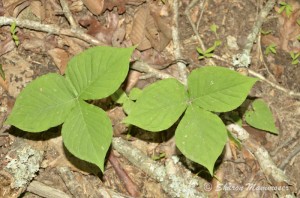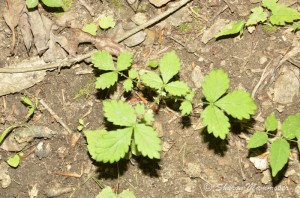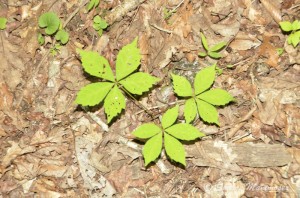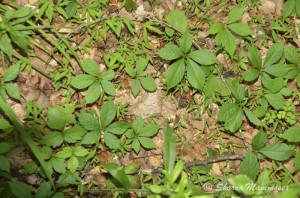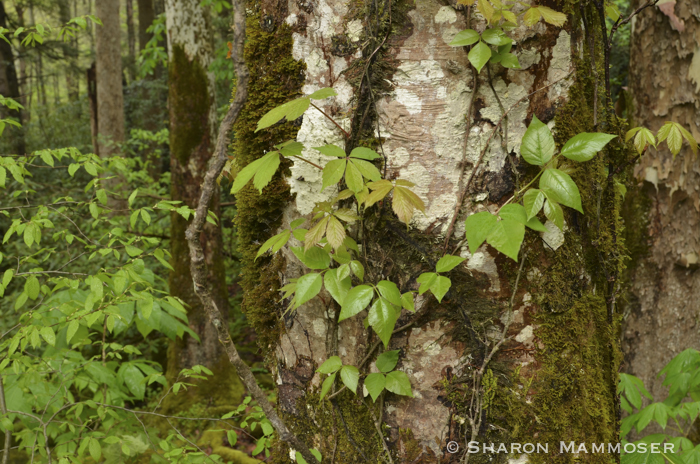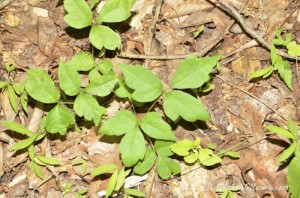
I recently had some family in town visiting for a week and spent many hours down by the pond in our front yard. In several places there is some poison ivy and though I know what it looks like and do my best to avoid walking in it, I still got the itchy rash associated with it. My mom, and likely MANY others like her, believe strongly–and cannot be convinced otherwise!– that if you get a poison ivy rash in one place on your body that you can spread it to another place, or even another person, by touching the rash when it is wet or oozing.
If you have a poison ivy rash on your arm, can you spread it to your leg? Does breaking the blisters and then touching another part on your body spread the rash?? Can someone who touches you or the rash then get poison ivy themselves?
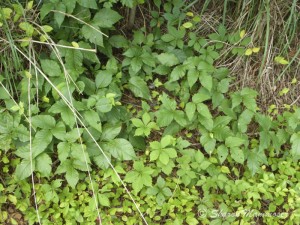
The answer to all of the above is NO.
If you have a poison ivy rash on your arm, you CANNOT spread it to your leg!
Breaking the blisters and then touching another part on your body WILL NOT spread the rash!
Someone who touches you or the rash CAN NOT then get poison ivy themselves!
The only way to get the itchy rash is to have contact with the oil–called urushiol (pronounced ooh-too-she-all.) This oil is very potent and can remain so for YEARS! This is likely why it seems like the rash is spreading–because the oil was never washed off the source in the first place and continues to cause the itchy rash.
There are MANY, MANY people who will not believe this no matter how many times I say it!
The only way to get the rash associated with poison ivy, is through contact with the urushiol oil.
You do not have to touch the plant to get the rash–you can touch something that has contact with the plant–be it an article of clothing, a dog’s fur, a shoe, a gardening tool, even someone’s hand if the oil is still on it.
Again, the only way to get the rash associated with poison ivy is through contact with the urushiol oil….
But many will argue with me, saying things like “But I wasn’t even in the woods and I got it! My husband has a rash with weeping blisters–I must have gotten it from the sheets in our bed!” Or ” But I had it on my hand and then the next day got a rash on my leg.”
Let me give an example of how this happens: Let’s say you took a hike and unknowingly walked through poison ivy. Now the oil is on the bottom of your pants and maybe your socks and even on your sneakers or hiking boots. So you get home and take these off. A day or so later you get the first rash. Boy is it itchy! The next day you put on your sneakers, touching the laces as you do. The next day, you have MORE poison ivy! Then, a week later you decide to wear those pants again, and putting them on, rub against some of the oil that is on them. A day later, you get a new rash, just as itchy! The next day you do laundry. As you are putting things into the washer, you touch the socks you had on that hike, the same ones with the oil on them and guess what? The next day you get a new rash–this time on your hand! See why it is so easy to think that the rash is spreading from one place to another?
The oil from the poison ivy and poison oak plant is very potent. It can last YEARS!
You can even have the oil under your fingernails and then further spread it from one place to another.
But it’s THE OIL that causes the poison ivy rash, not breaking of the blisters and touching somewhere else!
A wife or mother who gets the poison ivy rash and has never even been outside may be getting it from doing laundry from a person who have had contact with the plant and the oil. The oil can remain potent for a long time!
Also, a person who seems to be immune to the rash can suddenly lose this immunity and get the rash. Being immune today doesn’t mean you will always be immune. There was a period of time when I could walk in poison ivy all I wanted and NOT get it! But then one day that changed! My mother is so allergic she can look at it and get it! (just kidding, but she is REALLY allergic.)
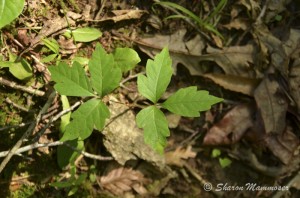
So learn to recognize poison ivy:
1. Poison ivy has three leaves.But so do lots of other plants including strawberries, raspberries, hog peanut, trillium, jack in the pulpit and more.
When it first comes up it tends to have reddish leaves and a reddish stem.
The leaves are shiny.
The bottom two meet in the middle and the top one is separated a bit.
The leaves are toothed, not smooth. In the fall, the leaves turn yellow.
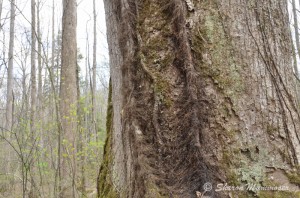
In review:
1. Learn to recognize poison ivy and try to avoid touching it! Also, you can get the rash from burning it–this is horrible! Don’t burn poison ivy! This includes the hairy vine that might be on a piece of wood. As my mom can tell you, people have to go to the emergency room when this happens and it’s not pretty. You can also get it from weedwacking it as the oils will be flung in every direction when the machine hits the plant.
2.If you know you’ve been in it, try to wash the exposed part of the body within ten minutes. Wash well! Use soap and scrub. This may or may not work, but it doesn’t hurt to try.
3. If you still get the rash, try a product called Ivarest. This is the only thing I have ever had success with, and I’ve been getting poison ivy for more than 30 years! As a photographer, I can’t always avoid it and just accept that I will get it and deal with it.
4. If you do get it, try to think back and remember what you were wearing. Then wash those clothes! Some people would advise throwing them out, though I think this is a little extreme. Remember, the oil lasts a long time! If you keep getting more poison ivy rashes, it must be on something you keep touching. If you have a dog or cat that goes outside, you can get the rash from touching your pet! Maybe it’s time to give Rex a really, really, really good bath!
5. Some cases are so severe, they require a doctor’s visit. (Maybe think about quitting those naps you insist on taking in the woods!)
If you don’t believe me, here are some other sources that will support these facts. ALL of them say the same thing!!
Medicinenet.com
Weed Science Society of America
